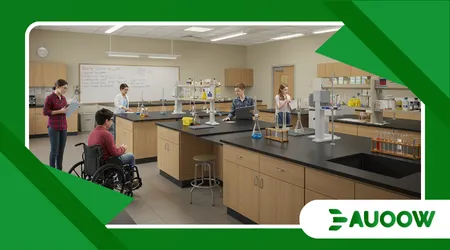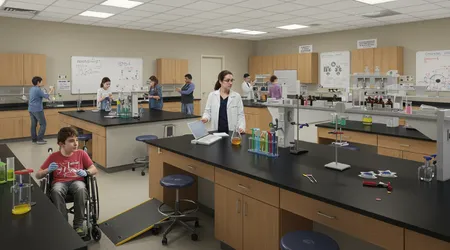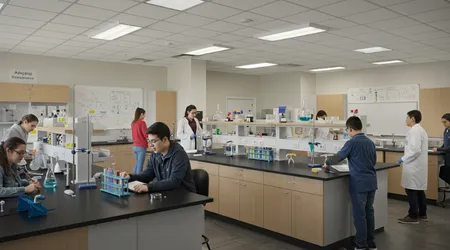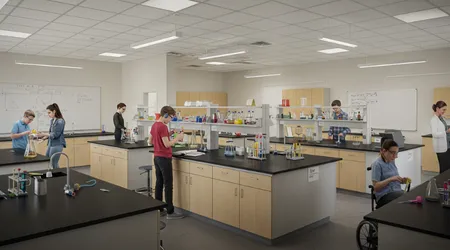Adapting Science Labs for Physical and Cognitive Accessibility

Adapting science labs for physical and cognitive accessibility is not just a trend it’s a moral and educational imperative.
In 2025, inclusive education demands that every student, regardless of physical or cognitive ability, has equitable access to hands-on STEM learning.
Science labs, often filled with complex equipment and fast-paced experiments, can pose significant barriers. Yet, with thoughtful design, innovative technologies, and a commitment to Universal Design for Learning (UDL), these spaces can become inclusive hubs of discovery.
Why should we limit who gets to explore the wonders of science? This article dives into practical, creative, and evidence-based strategies to make science labs accessible, ensuring all students thrive in STEM environments.
From adaptive tools to digital solutions, we’ll explore how to transform labs into inclusive spaces while weaving in real-world examples, current data, and actionable insights.
The Urgency of Inclusive Science Labs
Science labs are the heart of STEM education, where theory meets practice. However, for students with disabilities, these spaces can feel like obstacle courses.
Physical barriers, like inaccessible lab benches, and cognitive challenges, such as complex instructions, often exclude students.
The National Center for Education Statistics reports that 14% of public school students in the U.S. have disabilities, yet many labs remain ill-equipped. Adapting science labs for physical and cognitive accessibility ensures these students aren’t sidelined.
Inclusivity in labs fosters equity and empowers diverse talent in STEM fields. Without accessible labs, students miss critical hands-on learning opportunities.
++Supporting College Students with ADHD Beyond Accommodations
For instance, a visually impaired student might struggle with standard microscopes. Schools must prioritize accessibility to nurture future scientists.
Consider a wheelchair-using student navigating a cluttered lab. Fixed-height benches block their participation.
Simple adjustments, like adjustable workstations, can transform their experience. Accessibility isn’t charity it’s a right that unlocks potential.

Physical Accessibility: Redesigning the Space
Physical barriers in science labs often stem from outdated infrastructure. Narrow aisles, high countertops, and heavy equipment can exclude students with mobility impairments.
Adapting science labs for physical and cognitive accessibility starts with rethinking spatial design. Adjustable-height lab benches are a game-changer. They allow wheelchair users to work comfortably alongside peers.
Wider aisles, at least 36 inches per ADA standards, ensure smooth navigation. Non-slip flooring and clear signage also enhance safety.
Also read: Supporting College Students with ADHD Beyond Accommodations
For example, a student with cerebral palsy at a California high school used a motorized wheelchair. After installing adjustable benches, they conducted experiments independently.
Tactile markers and braille labels further support visually impaired students. Schools can also invest in lightweight, ergonomic tools to reduce physical strain. These changes create labs where everyone can engage fully.
Cognitive Accessibility: Simplifying the Experience
Cognitive accessibility addresses how students process information in labs. Complex instructions or fast-paced experiments can overwhelm students with learning disabilities.
Adapting science labs for physical and cognitive accessibility means simplifying without dumbing down. Clear, concise protocols with visual aids help students with autism or dyslexia follow along.
Digital simulations offer step-by-step guidance, reducing cognitive load. For instance, a Texas school used virtual lab software to help a student with ADHD master chemistry concepts. Structured workflows, like numbered steps, also improve focus.
Read more: Supporting College Students with ADHD Beyond Accommodations
Assistive technologies, such as text-to-speech software, aid students with reading difficulties. These tools ensure instructions are accessible, fostering independence. Cognitive accessibility empowers students to engage with science confidently.
Leveraging Assistive Technologies

Assistive technologies are revolutionizing lab accessibility. From voice-activated devices to haptic feedback tools, innovation is key.
Adapting science labs for physical and cognitive accessibility thrives on tech integration. For example, a visually impaired student in a U.K. university used a talking microscope with audio output to analyze samples.
Virtual reality (VR) labs allow students to practice experiments safely. A 2024 study in Educause Review found that VR labs improved engagement for students with disabilities by 30%. Haptic gloves help those with motor impairments manipulate virtual objects.
Speech-to-text software supports students with limited dexterity in recording data. These technologies bridge gaps, making science accessible and engaging for all.
Universal Design for Learning (UDL) in Labs
UDL principles guide inclusive lab design by offering flexible learning pathways. Adapting science labs for physical and cognitive accessibility aligns perfectly with UDL’s focus on diverse needs. Multiple means of engagement, like interactive simulations, keep students motivated.
Providing varied representation text, audio, or video instructions caters to different learning styles. For example, a biology lab in Ontario used video demos alongside written protocols, benefiting students with cognitive disabilities.
UDL also emphasizes actionable feedback, helping students improve iteratively.
Teachers can offer choices, like group or solo experiments, to suit individual preferences. UDL transforms labs into inclusive, dynamic spaces where every student thrives.
Training Educators for Inclusion
Even the best-designed labs fall short without trained educators. Teachers need skills to support diverse learners effectively.
Adapting science labs for physical and cognitive accessibility requires professional development in inclusive practices. Workshops on UDL and assistive tech empower educators to adapt lessons.
For instance, a Chicago school district trained teachers to use tactile diagrams for visually impaired students. This small change boosted participation. Ongoing training ensures educators stay updated on accessibility tools.
Collaboration with special education experts also helps tailor lab activities. Educators become advocates for inclusion, creating equitable learning environments.
Policy and Funding: Driving Systemic Change
Accessibility requires institutional support through policies and funding. Schools need budgets for adaptive equipment and training.
Adapting science labs for physical and cognitive accessibility demands systemic commitment. The U.S. Department of Education’s 2025 budget allocates $13 billion for special education, yet gaps remain.
Clear policies mandating accessible lab design are crucial. For example, a New York school district implemented a policy requiring all new labs to meet ADA standards. Advocacy from parents and students can drive policy changes.
Grants from organizations like the National Science Foundation support accessibility upgrades. Systemic change ensures long-term inclusivity in STEM education.
Real-World Examples of Accessible Labs

Real-world examples show accessibility in action. At Stanford University, a chemistry lab installed adjustable benches and VR simulations, enabling a student with quadriplegia to participate fully. This success highlights the power of intentional design.
In Australia, a high school partnered with a tech firm to provide haptic feedback devices. A student with motor impairments used these to conduct physics experiments, gaining confidence. These stories prove accessibility unlocks potential.
Another example: a U.K. college used voice-activated software to help a student with dyslexia record lab data. Practical solutions like these inspire broader adoption.
The Ripple Effect of Accessibility
Accessible labs do more than benefit students with disabilities they enhance learning for all. Clear instructions and flexible tools improve engagement across the board.
Adapting science labs for physical and cognitive accessibility creates a ripple effect, fostering collaboration and innovation.
Imagine a lab as a symphony orchestra. Each instrument (student) plays a unique role, but only together do they create harmony.
Accessibility ensures no one is left out. Schools that prioritize inclusion see higher student satisfaction and retention.
Accessible labs also prepare students for diverse STEM careers. By modeling inclusivity, schools inspire future scientists to value equity.
Table: Key Accessibility Features for Science Labs
| Feature | Purpose | Example |
|---|---|---|
| Adjustable Lab Benches | Accommodate wheelchair users | Height-adjustable workstations |
| Tactile Markers | Aid visually impaired navigation | Braille labels on equipment |
| Virtual Reality Simulations | Provide safe practice for all | VR chemistry lab software |
| Text-to-Speech Software | Support students with reading difficulties | Voice-activated data recording |
| Clear, Visual Instructions | Reduce cognitive load | Numbered steps with icons |
Conclusion
Adapting science labs for physical and cognitive accessibility is a transformative step toward equitable education.
By redesigning spaces, leveraging technology, and embracing UDL, schools can empower every student to explore science. From adjustable benches to VR simulations, the tools exist to make labs inclusive.
Educators, policymakers, and institutions must collaborate to drive change. The ripple effect of accessibility benefits all, fostering innovation and diversity in STEM.
Let’s commit to labs where every student can shine, creating a future where science knows no barriers.
FAQs
Q: What is the first step to make a science lab accessible?
A: Conduct an accessibility audit to identify physical and cognitive barriers, then prioritize adjustable equipment and clear instructions.
Q: Are assistive technologies expensive for schools?
A: Costs vary, but grants and open-source software, like free text-to-speech tools, can make implementation affordable.
Q: How does lab accessibility benefit all students?
A: Clear instructions and flexible tools enhance engagement, improve collaboration, and create a more inclusive learning environment for everyone.
